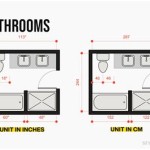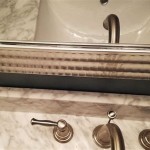What Color Floor Makes a Small Bathroom Look Bigger?
The perception of space in a small bathroom is significantly influenced by the color of the flooring. Strategic color choices can visually expand the room, creating a more open and airy feel, while poor choices can make the space feel cramped and claustrophobic. Understanding the principles of color theory and how they apply to spatial perception is crucial for making informed decisions about bathroom flooring.
This article explores the color options that can enhance the sense of spaciousness in a small bathroom, addressing the underlying reasons for their effectiveness and providing practical considerations for implementation. The goal is to provide a comprehensive guide for homeowners and designers seeking to optimize the visual dimensions of a compact bathroom.
The Power of Light Colors
Light colors are generally the most effective at making a small bathroom appear larger. Specifically, white, off-white, pale gray, and light beige tones reflect light, brightening the room and creating an illusion of increased space. The more light that is reflected, the less defined the boundaries of the room become, blurring the edges and making the bathroom feel more open.
White is often considered the quintessential color for maximizing space. Its reflective properties are unparalleled, and it creates a clean, minimalist aesthetic that is highly conducive to a sense of spaciousness. However, choosing the right shade of white is important. A stark, sterile white can feel cold and unwelcoming, while a warmer, slightly off-white can add a touch of comfort without sacrificing the benefits of reflectivity.
Pale gray is another excellent option, offering a sophisticated alternative to white. Light gray tones provide a subtle contrast that prevents the room from feeling too washed out, while still maintaining a high level of reflectivity. This makes it a versatile choice that can complement a wide range of bathroom styles, from modern to traditional.
Light beige provides a warmer alternative to white and gray. Beige tones create a cozy and inviting atmosphere, while still contributing to the perception of spaciousness. Like gray, choosing the right shade of beige is crucial. Avoid darker, more saturated beiges, as these can absorb light and make the room feel smaller.
The texture of the flooring material also plays a role in how light is reflected. Smooth, glossy surfaces are generally more reflective than textured, matte surfaces. Therefore, choosing a light-colored tile with a glossy finish can further enhance the sense of space.
Utilizing Cool Tones
Beyond light colors, cool tones, such as light blues and greens, can also contribute to the perception of a larger bathroom. Cool colors tend to recede visually, meaning that they appear to be further away than they actually are. This creates a sense of depth and spaciousness, making the room feel more open.
Light blue is a particularly effective choice for bathrooms, as it evokes a sense of tranquility and cleanliness. It can also complement a wide range of fixtures and accessories, making it a versatile option for various design styles. Pastel blues are particularly effective at maximizing space, while darker, more saturated blues can have the opposite effect.
Light green is another calming and refreshing choice for bathroom flooring. It brings a touch of nature into the space, creating a sense of serenity and relaxation. Like blue, pastel greens are generally more effective at maximizing space than darker, more saturated greens.
When using cool tones, it is important to consider the overall color scheme of the bathroom. Combining cool-toned flooring with warm-toned walls or accessories can create a sense of imbalance and disharmony. It is generally best to stick to a consistent color palette, using different shades and textures of cool colors to create visual interest.
Additionally, the lighting in the bathroom plays a crucial role in how cool tones are perceived. Cool-toned flooring can appear dull and lifeless under warm lighting, while warm-toned flooring can appear yellow and unattractive under cool lighting. Choosing the right lighting is essential for creating a harmonious and visually appealing space.
Strategic Use of Pattern and Texture
While light and cool colors are generally the most effective at making a small bathroom appear larger, the strategic use of pattern and texture can also contribute to this effect. Specifically, large-format tiles, linear patterns, and subtle textures can visually expand the room and create a sense of depth.
Large-format tiles minimize the number of grout lines, creating a more seamless and continuous surface. This reduces visual clutter and makes the room feel more open and expansive. Choosing large-format tiles in a light color can further enhance this effect, creating a bright and airy space.
Linear patterns, such as stripes or planks, can visually elongate the room, making it feel longer and wider. Running the pattern lengthwise can make the room appear longer, while running it widthwise can make it appear wider. However, it is important to avoid overly busy or intricate patterns, as these can overwhelm a small space and make it feel even smaller.
Subtle textures can add visual interest and depth to the flooring without overwhelming the space. Textures such as wood grain or stone patterns can create a sense of realism and dimension, making the room feel more inviting and comfortable. However, it is important to avoid overly rough or bumpy textures, as these can be difficult to clean and can create a tripping hazard.
The size of the pattern should be proportionate to the size of the bathroom. A large, bold pattern can overwhelm a small space, while a small, intricate pattern can get lost and look cluttered. Choosing a pattern that is appropriately scaled to the size of the bathroom is essential for creating a visually balanced and harmonious space.
Furthermore, the direction of the pattern can significantly impact the perception of space. Diagonal patterns can create a sense of dynamism and movement, making the room feel more interesting and visually stimulating. However, diagonal patterns can also be visually busy and overwhelming, so it is important to use them sparingly and with careful consideration.
In conclusion, while color is a primary factor, the choice of pattern and texture, when combined with a considered color palette, can significantly enhance the perception of space in a small bathroom. These elements, when implemented strategically, contribute to a more visually appealing and functional environment.

How To Make A Small Bathroom Look Larger Room For Tuesday

12 Ways To Make Any Bathroom Look Bigger

12 Ways To Make Any Bathroom Look Bigger

19 Tricks To Make A Small Bathroom Look Bigger First Choice Warehouse
:strip_icc()/102200960-7816449351bd4619848c79f6c8f15fd9.jpg?strip=all)
30 Styling And Design Tips To Make A Small Bathroom Look Bigger

Design Tips To Make A Small Bathroom Look Bigger Porch Daydreamer

8 Ways To Make A Small Bathroom Look Bigger

19 Tricks To Make A Small Bathroom Look Bigger First Choice Warehouse

12 Ways To Make Any Bathroom Look Bigger

8 Ways To Make A Small Bathroom Look Bigger
Related Posts







